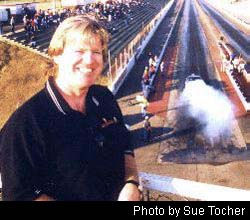|

8/8/03
Paying the Price
For 'Poor Planning'

 n what has to be a disturbing trend for the
IHRA, several tracks it's visited recently just
haven't seemed ready to host national events.
And the tracks' lack of preparedness has extended
far beyond their racing surfaces to inadequate
pit facilities, unpaved return roads, and a
general look of last-minute repairs. Why does
this happen? The schedule typically is set more
than a year in advance and presumably each venue
is told what to expect and what's required.
n what has to be a disturbing trend for the
IHRA, several tracks it's visited recently just
haven't seemed ready to host national events.
And the tracks' lack of preparedness has extended
far beyond their racing surfaces to inadequate
pit facilities, unpaved return roads, and a
general look of last-minute repairs. Why does
this happen? The schedule typically is set more
than a year in advance and presumably each venue
is told what to expect and what's required.
The problem first cropped up in Edmonton, Canada, where by IHRA's admission, local crews were still paving service roads on Thursday before the big race weekend began. Then came the debacle in Milan, MI, where not only were pit facilities lacking, but the racing surface itself was well below par for a national event. Now, both of these venues were first-time hosts for an IHRA national, but then came the race a couple of weeks ago at Toronto Motorsports Park, where again venue preparations were going on immediately before racers and fans arrived -- preparations that were addressing unresolved items left over from last year's inaugural event.
To be fair, by all accounts the last-minute work at Bud Park in Edmonton went off without a hitch, but questions still must be asked why it wasn't completed earlier. When NASCAR, or for that matter, NHRA, introduces new tracks to their circuits, I've yet to see even unplanted flower beds in the background. I realize IHRA and most of its member tracks don't have the same resources as those other circuits, but if they want to present and project a professional image they have to at least finish construction well before the first trailer pulls in.
The Milan race deserves special mention since it wasn't necessarily the venue that was lacking, but the actual field of competition. A prominent IHRA Funny Car driver told me he'd never seen a track before where they'd laid only about a 12-feet-wide strip of concrete down the center of each 20-foot lane to the half-track point. Plus, the concrete was elevated up to half an inch above the adjacent asphalt, he said, so if a powerful car "fell off" the concrete -- especially while doing a wheelie -- it quickly became a no-win situation. "You work so many years to get to where you run fast, and then you get to a track like this where you had to run on a tightrope, literally, because if you drifted either way you were off the concrete and headed for the wall," he said. "It was a bad combination; the track was bad and I was fast."
To make matters worse, the Milan track was supposed to have been ground and resurfaced a couple of weeks before the national event crowd was scheduled to arrive, but while in Edmonton IHRA President Bill Bader told me he received a call from Milan track owner Bill Kapolka, who told him the grinding company was unavailable. "It was poor planning," Bader stated, later adding that "disappointed is a good word" to describe his feelings upon seeing the Milan strip.
That this happened in Detroit's backyard, a market long coveted by every major sanctioning body, doesn't bode well for IHRA either. Sure, the stands were packed this year, but if the racers aren't happy and not able to put on a good show (only two of the seven Top Fuel elimination rounds were free of tire smoke and the event-winning pass was an anemic 5.00 at 252 mph), how long will that continue? And if you were a sponsor considering getting involved, would you have left Milan impressed? That's a chance IHRA or its member racers cannot afford to take.
Matters weren't helped either when everyone arrived at Toronto, where "the track looked exactly like it did the day we left it last year," a leading Pro Mod team owner told DRO. Then there was the photo posted on the Internet showing the trailer carrying Bruce Litton's Top Fuel operation sunk into the ground at his pit stall. Is this how the "kings of the sport" should be treated at IHRA national events?
All of these problems point to a need for action. It's time for IHRA to send a knowledgeable advance person to each venue at least a month or two before every national event in order to allow time to make changes, if necessary. This person should not only be extraordinarily observant, but also work from a checklist -- and then he should return a couple of weeks before each event to be certain any needed repairs were done.
And every track should be a part of this program, regardless of where it is or how long it's been part of the program. Of course, long established venues like Norwalk, Rockingham, and Virginia won't require the same oversight that Edmonton, Milan, and Toronto might need, but it certainly wouldn't hurt to annually review every IHRA stage to constantly seek out improvements.
I realize a program like this will impose an added cost to IHRA and its tracks, but I can't help feeling that not to do so and ending up looking unprepared and unprofessional will exact a much higher price in the long run. 
Race safe,
|
Previous
Story
|
Tocher
Talks —
7/10/03
When did IHRA become the Canadian Hot
Rod Association? |

|